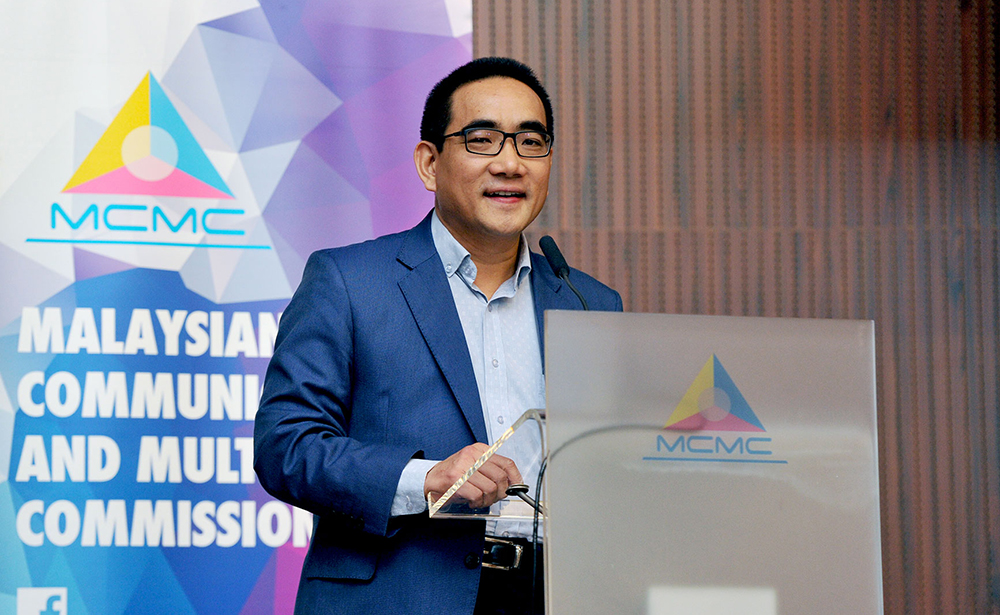Bringing the nation up to speed: The journey to 5G
By Sharmila Ganapathy April 4, 2019
- 4G and 5G can co-exist for a long time
- Commercial deployment of 5G is possible in 2021

IN THE race to implement 5G, Malaysia has no intention of being left biting the dust of other Asian countries. However, as Gerard Lim Kim Meng (pic), chief officer, Digital Industry Development & Commercialisation at the Malaysian Communications and Multimedia Commission (MCMC) tells Digital News Asia in a recent interview, actual implementation will take time.
“5G is not something that will be that soon, some parts of 5G will be available next year, but even that is being super-optimistic, some of my colleagues say,” he quips.
He also points out that the actual 5G specifications will only be ratified by the end of this year, and only then will the vendors and suppliers be able to meet the software specifications. “On our side, it will be dependent on the availability of spectrum,” he says.
He explains that MCMC is currently doing a spectrum study called the “Reallocation of spectrum bands for use by mobile broadband service”, that will conclude end-April.
The study is being done to ensure spectrum availability for mobile broadband services, including that of 5G. “There will be spectrum rationalisation and we will also be able to identify what spectrums can be made available for the deployment of 5G.”
“In Malaysia, the spectrum that we issue to licensees is not bound by specific technologies, it is agnostic. Naturally 5G will gravitate towards frequencies that have been agreed upon where it will be operating on, such as 28Ghz, 3.4-3.6Ghz; we are looking into those frequencies and 700Mhz. We haven’t any firm decisions made on 700Mhz because of the ongoing study, which will be ready for the second half of this year.”
Following the study, Lim says, MCMC “will be clearer in terms of spectrum that we will make available that will be more aligned to global deployments of 5G”. To a question on when commercial deployment of 5G is possible, he says that it will likely be 2021.
“5G is a long-term game. In Malaysia, 4G LTE took about seven years and still hasn’t reached 100% coverage. What you’re going to see this year is proof of how 5G can be used and there is a clear plan with our service providers,” he explains.
The plan going forward
We ask Lim about the 5G implementation strategy under the National Fiberisation and Connectivity Plan (NFCP) and he says that the 5G taskforce set up in November last year is well underway.
It currently has more than 60 member organisations he says, comprising various industry groups, business associations, communications equipment vendors, academia, ministries and their agencies.
“Under the taskforce, there are four working groups on 5G regulation, infrastructure, spectrum issues and use cases,” he adds.
“We’ve set up 5G test beds in Cyberjaya and Putrajaya. One of the 5G test networks set up in Putrajaya went live on April 1. The four other test networks in Putrajaya will be up and running throughout April,” he shares, adding that there will be a 5G showcase launch in Putrajaya during the third week of this month.
According to him, they are already using the test networks to test several applications across nine verticals, namely e-health, media/entertainment, smart city, automotive, manufacturing, public safety, education, agriculture and energy.
“Beyond faster mobile connectivity, 5G will be driven by certain industry applications, hence the emphasis on the nine verticals. We want to see genuine use cases in these verticals,” he says.
He gives the example of drones as 5G use cases that are currently under discussion. “There will be uses of 5G-enabled sensors on drones for agriculture, safety, emergency services. These will open up new possibilities in applications and use cases. With 4G the network cannot respond quickly enough, but 5G takes one-tenth of a second and can be used for drones that are run autonomously.”

Peaceful co-existence
Lim also believes that 4G and 5G can co-exist for a long time yet and this is because 4G LTE and especially LTE-Advanced (LTE-A), are more than capable of handling long-term usage for smart devices.
“We need to ensure that the LTE networks are set up properly, there is still a lot of fine tuning that needs to be made for 4G LTE, there is still room to improve.”
In fact, Lim points out that if a network is optimised for LTE-A, we’d be looking at average speeds of 50Mbps to 60Mbps. And if 5G could deliver fixed wireless access, speeds could be as high as 100Mbps to 200Mbps for end users, with its super low latency and high throughput.
In this respect, 5G would answer the call of the NFCP to increase broadband coverage and make it pervasive throughout the country.
Very real security concerns
Despite the 5G optimism however, there are concerns with the Huawei security fiasco that security concerns could crop up for countries that are aiming to implement 5G, especially with the firm being such a major player in the 5G scene.
When asked what MCMC’s stand is on the matter, Lim says: “We do need to take an approach that the view of the security of critical infrastructure needs to be taken into account for all vendors, irrespective of their origination, country or specific brands.”
“Security is important and whether 5G or existing technologies, we need to be aware that there is an underlying important critical issue. It is not only the provider of the tech, but also the security of the operational infrastructure and procedures. Security will be broken at the weakest link, and this might just be an operator. Someone could leave the backdoor open or a password lying around, there are all kinds of vulnerabilities,” he adds, saying that MCMC looks at security from a holistic point of view.
He is confident however, that the 5G standards that have been designed are up to par. “5G does come with very specific standards and if you follow those standards, 5G is by design a secure network and governed by very clear standards.”
For now, it will be interesting to see what the results of the spectrum study will reveal about the future of 5G in Malaysia and who gets what spectrum. Will 5G surpass what 4G LTE has managed to achieve to date? That remains to be seen, and not just for Malaysia.
Related Stories :


